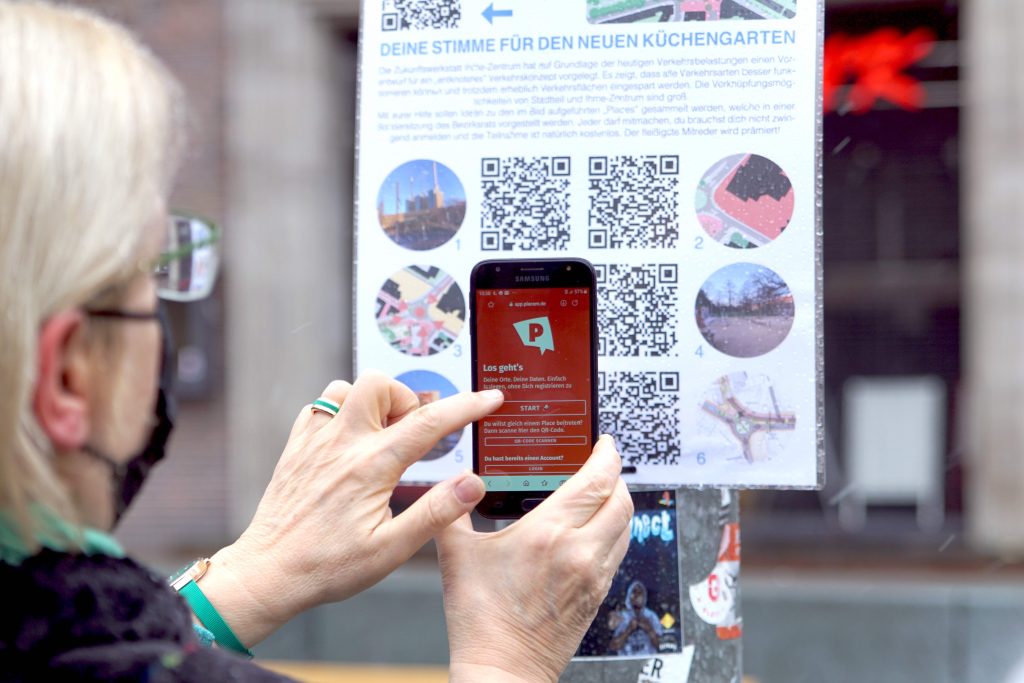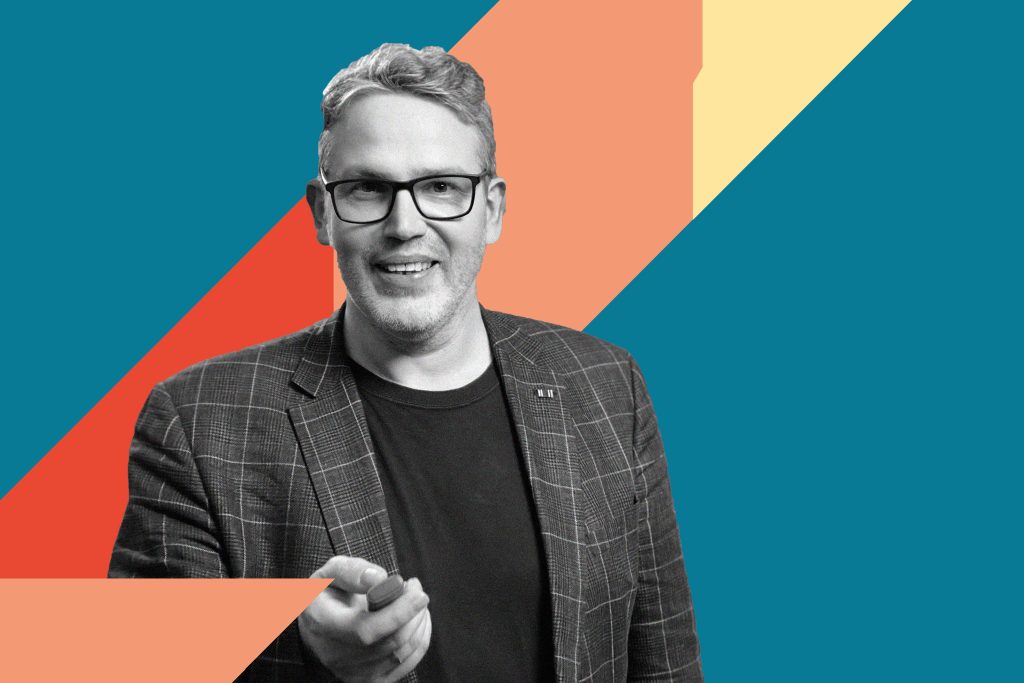Democracy Technologies: What exactly was the motivation to start PLACEm? What was missing?
Gregor Dehmel: There was a lack of an everyday experience of democracy. At Politik zum Anfassen, we usually conduct simulation games; for example, young people gather in the town hall, put their heads together and discuss their ideas. For three days, they experience how exciting democracy is. Studies have shown this is highly effective and increases political efficacy and participation willingness, but it’s only three days.
We wanted to do something more suitable for daily life, so we looked for ways to create a democratic experience possible in a simple way. We struggled to find an existing solution, so we made our own.
DT: What is the basic idea behind the app?
Gregor Dehmel: The user experience is quite simple. I scan a QR code at a place that matters to me, making me a member of the digital place. Once a member, I can be informed about what is happening there, get involved and share my ideas.
If you are implementing the app, for example, because you work at a youth centre and want to involve the people who come there, you set up a digital place on PLACEm and hang up the QR code at the centre. The young people become members, and you can contact them on the app. You can use it for information, for example, sending them a push notification telling them when you are open or involving them in deciding about future events at the centre.
This also works in urban development; for example, when redesigning a city square, you can set up a place, and from there on out, reach and involve the people living and working there.
DT: Do you have an example of how this has played out in real life?
Gregor Dehmel: Beeskow, Brandenburg, has a youth centre called Pier 13. The social workers there wanted to know what the young people not coming to the youth centre were doing instead. So, they identified 21 places in Beeskow where young people hang out and set up PLACEms. They asked questions like “What do you do in your spare time?”, “Where do you go to school?”, “What kind of services do you need?”. They also made themselves available to the young people via the app, telling them, “Next Wednesday at 3 pm, I will be here; if you want to talk, I am there”. They did this for over half a year, and it worked really well.
DT: What kind of feedback have you gotten from users and politicians?
Gregor Dehmel: The young people we have heard from love it. The app works well, especially with a gamification element where the users can win participation points and exchange them for rewards in various spaces in the city.
Of course, sometimes, it does not work well. Politicians usually get curious once it does work somewhere. We have very few municipalities where the politicians are the ones to introduce the app. I think digital participation is still daunting for politicians; it takes courage to implement it.
DT: Why do you think politicians are not making use of digital tools like PLACEm as much as they could?
Gregor Dehmel: I honestly have no idea because it is straightforward. I download the app and create templates. It takes 30 seconds. It’s not a significant loss if it doesn’t work; I don’t have to make a ten-year plan and provide it with a six-figure sum in the budget; I can test it a little bit. Politics often lack the courage to try new things and let projects fail. Everything must be perfectly planned.
DT: When a direct participation process fails, or citizens demand a change that was not implemented, maybe because the number of people involved was too small to represent the will of the people. It is often argued that if a participatory process is not implemented properly; it further damages trust in democracy. You don’t agree with this?
Gregor Dehmel: There is this idea that it is better not to have any participation than doing it imperfectly, which is entirely contradictory. I don’t think it is a problem for there to be an openness to the results of a participatory process if you communicate it outrightly. You can be transparent with the people you are involving, tell them you are trying something new, and it is unclear how the results of this process will be implemented. If you fail, you can all look at the process together and learn how to approach it next time.
DT: What are some good participation figures or quotas from your projects?
Gregor Dehmel: I don’t have a quota in mind because I don’t know the total number of people who could theoretically have been involved. But regarding numbers, for example, here in Altwarmbüchern, which has 9000 inhabitants there were over 100 ideas handed in for the youth square, which is incredible.
Of course, some people had multiple ideas, but we reached an incredible number of young people. Then, we organised their thoughts and voted on three alternatives. In the end, only around twelve young people on the platform took part in the final vote. But they are building something great now. This was a very successful participation process in a short period of two months.
When you look only at the numbers, you must remember that a digital participation tool is only a small part of the participation process. There are also meetings in the youth club, a letterbox to drop your ideas into, and the digital tool. If the digital tool contributes to reaching someone I wouldn’t have reached otherwise, I already gained a lot, whether one person, ten or a hundred.
DT: It sounds like anyone who is in the physical space with the QR code for a PLACEm can participate. Is there a way you authenticate the users so that only young people or only a specific group of people can participate?
Gregor Dehmel: For now, there are no authentication mechanisms within the app, so the QR code’s publicity determines the level of public exposure. When I display the QR code somewhere, everybody who sees it there can participate. If I want to reach a narrow group, I either have to hand it over personally or for example, stick it into a textbook so that only those in a specific class can access it. In some schools, we have a system where the secretary’s office has the code, and you show them your ID card to get access. This summer, we plan to implement an authentication tool with a TAN function, enabling hybrid voting processes with many more participants.

DT: What would you recommend to somebody who would like to start a similar project?
Gregor Dehmel: My first recommendation is to just do it. This is important for any participation process; try it out, and find out what suits you, your institution or your community. There is no one size fits all tool – for us, it was an app, but for others, it might be something different.
Another thing we realised pretty quickly is that you will need to put a lot of effort into spreading the word. It takes time for people to become aware of and start using your app. Many municipalities have yet to realise that there is a need for something like PLACEm, so we did a lot of conferences, videos, and interviews to tell many people about the app and why it’s necessary.
DT: What were some of the other key challenges in the project?
Gregor Dehmel: One challenge is finding people to take on team leadership; we still have some vacancies there. We are not sure why; maybe because it is harder to grasp the app. With the app, it’s incredibly difficult to approach the right candidates.
Initially, we also struggled to find programmers who spoke our language. By that, I don’t mean German or English – the computer science sector has a very different approach to app development than the social/non-profit sector. We are not tech people, but we have a clear picture of what we need the app to do. Finding somebody with whom we could develop that together on an equal footing was a longer process.
DT: Who would you say are the people whose contributions were particularly important to the project’s success?
Gregor Dehmel: On one hand, there are those who were courageous and tried PLACEm out even without our help. Some of them we only know of because we got a Google Alert that somebody was using the app and doing their own thing with it. We are grateful to those youth workers, citizen initiatives, communities, and young people who were brave enough to try out PLACEm. Because only with their success stories can we promote it further.
Winning the democracy promotion prize at the Google Impact Challenge 2018 also really helped us. I don’t know what we would have done without the €500,000 we won there.
Currently, we have support from the Federal Ministry of the Interior which is also helping us to popularise the app in social clubs and associations, such as the volunteer fire brigades.
So there are these two levels of impact: on the one hand, the individual youth club that has an idea on how to use PLACEm, and the people who have money and resources to support us.
